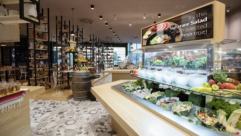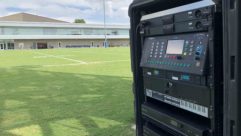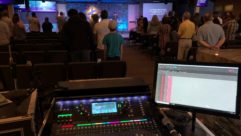BRING OUT THE SUNGLASSES
Feb 1, 2001 12:00 PM,
By Peter Putman, CTS
LED Displays and Ambient Light Slug It Out
LEDs can provideof imaging horsepower that plasma won’t ever beable to touch.
The Light Emitting Diode panel is a unique beast, combiningemissive display technology with super-large screen arrays.
IN THE COURSE OF MY RESEARCH AND testing of electronic displays,I come across all kinds of “next best things” and“the last display you’ll ever need” products. Many ofthem never make it past the drawing board. Other designs areinterminably stuck in laboratory testing with their manufacturerson an endless quest for funding.
While flat-matrix projectors and monitors tend to dominate thenews, there is one alternate display technology that is well pastthe laboratory stage and in fact has been providing bright,contrasty big-screen images for some time now. The Light EmittingDiode panel is a unique beast, combining emissive displaytechnology with super-large screen arrays and generally workingwhere DLP, LCD and plasma display panels fear to tread.
The concept of creating an image using a matrix of emissivedevices isn’t new — light bulbs have been arranged in rowsand columns to create words and pictures for several decades. Ofcourse, conventional bulbs are impractical for today’s electronicdisplay requirements as they dissipate too much heat and theirswitching times are too slow for video and other fast-refresh imagesources.
LEDs, on the other hand, can be cycled on and off at extremelyhigh speeds — certainly fast enough to accommodate a 60Hzvideo rate. They’re also quite small and are available in red,green and blue, the primary building blocks of additive color.
However, their round construction poses a bit of a quandary: Howdo you design an electronic display with this shape? Is it possibleto pack LEDs together tightly enough to create a unified field ofpixels without excessive spacing between individual pixels?
GETTING THE LEDS OUT
To solve this mystery, we need to think outside the box and lookat another, similar imaging system: the printer’s dot screen. Ifyou inspect a magazine photograph with a powerful magnifying glass,you’ll notice that the photo is actually made up of thousands oftiny dots. Viewed in extreme close-up, the dots appear to be justthat — a collection of dots.
A funny thing happens as you increase the viewing distance. Thedots seem to disappear, and all you see is a continuous-tonephotograph! At some point, your eyes can no longer resolve theindividual dots (pixels), and the construction of the photograph(display) is not apparent — you can only see the reproducedimage.
That’s exactly how an LED display works. Depending on themanufacturer, LEDs are arranged in clusters, with each clustercontaining red, green and blue LEDs. One such cluster forms a pixel(some actually resemble a die with the “5” sideshowing), and thousands of these pixels are joined in stripes tobuild a huge electronic display. Stand far enough away from thisaggregation of LEDs, and you see a smooth image with little of thepixel elements evident.
Because the pixel pitch (physical size of an RGB LED array) isfairly large compared to flat-matrix displays, the viewingdistances must be greater to minimize the apparent structure.Typical LED pixel pitches can range from as small as 10mm to aslarge as 20mm, which is quite coarse for close-up viewing. Incontrast, even the largest plasma display panels have a dot pitchof just over 1mm, while a typical 27-inch TV set has a dot pitch of0.8mm on center.
The NTSC rule of thumb specifies that for viewing a standard TV,we’d want to be positioned at seven times the screen height so asnot to notice the scan lines. That “7-times rule” wasbased on a 20-inch diagonal TV set. Assume a 0.8mm dot pitch for awell-designed consumer TV set, and we can establish a ratio of31.75 dots per inch, or 381 dots vertically in a 20-inch diagonalpicture (picture height is 12 inches).
Now, let’s do some interpolation for a comparable LED displaywith a dot pitch of 10mm and a specified resolution of 100 linesper meter. To watch 525-line video, we’d need a display measuringabout 17 feet tall. Using the NTSC 7-times viewing distanceguideline, we’d want to be positioned almost 120 feet away from thedisplay for it to appear “normal!”
Selecting LED arrays with a 4mm dot pitch — the smallestcurrently available — would result in a display 40% the size,or around 7 feet. Even so, we’d still want to be positioned about50 feet from the display so the scan lines in an NTSC image areunnoticeable.
As you can see, LED displays are best suited for large venues,such as concert halls, arenas and stadiums. And that’s exactlywhere the majority of them wind up, but there’s another reason forthese site choices: image brightness.
BRIGHT LITTLE BULBS
Typical brightness specifications for LED walls are severalorders of magnitude higher than conventional direct-view or evenprojection video monitors. Let’s assume you’d want to build avideowall using rear-projection cubes that would result in abrightness reading of 25 foot-lamberts, suitable for an indooratrium mall.
Using some quick math (25×3.42) gives us a reading of 85.5candelas per square meter. Since one cd/m2equals one nit, our wall can produce an image of 85.5 nits. Withthe latest in flat-matrix rear-projection technology, we canprobably coax as much as 120 to 150 nits from the displays whilemaintaining acceptable contrast levels.
In contrast, a typical LED wall can produce from 700 to 1,000nits, or 10 times the luminance. That works out to 200 to 300foot-lamberts, which is a bright image in anyone’s book.These high levels of brightness make LED displays the most logicalchoice for imaging under full daylight, which can measure in excessof 1,000 to 2,000 nits indirectly and well over 5,000 nitsdirectly.
Some models of LED walls are capable of over 3,000cd/m2 luminance, which makes for anexceptionally bright image on a bright, cloudy day. Needless tosay, that’s a level of performance that’s beyond flat-matrixprojectors and monitors, which are generally happier with lowerlight levels and more controlled viewing environments.
LED displays are always constructed from blocks of LED pixels,so there’s no limit to how large they can be, or what shape theymay take. LED walls have been constructed in conventional squaresand rectangles, and even long and narrow shapes such as theRavenVision electronic displays at PSINet Stadium in Baltimore,each of which measures about 25 feet tall by 100 feet wide.
As far as signal resolution, the majority of LED walls that I’veseen process all signals as progressive-scan VGA (essentially, a640×480 60Hz signal). This means that all sources are up- ordown-converted to a 31.5kHz rate, and I have yet to see a LEDdisplay that can achieve higher refresh rates than 60Hz. Is this adrawback? Not really, as we aren’t looking for HDTV quality so muchas we want super-bright images.
LED walls are staking their own place in the permanent installand staging/rental markets. Three major manufacturers of LEDdisplays are Barco of Kennesaw, Georgia; Lighthouse Technologies ofCary, North Carolina, and Saco Smartvision of White Plains, NewYork.
Barco. A relative newcomer to the industry, Barco gained entrythrough their purchase of Dr. Seufert GmbH and that company’s LEDwall technology. Recently, Barco worked with San Francisco OutdoorTV (formally known as Video Board Ventures) to install a9’×15′ Barco DLite 7 Daylight Display LED videowall at Pier 39in the Fisherman’s Wharf section. San Francisco Outdoor TV featuresprogramming on the videowall that is of interest to tourists,including segments on the city’s history and uniqueattractions.
The DLite 7 wall has a fine pixel pitch of 7mm and is specifiedto have 5,000 nits light output with extremely wide viewing angles.It features built-in intelligence that enables auto-configurationand allows hot swapping of LED tiles without interrupting thedisplay of the pictures. The videowall is mounted approximately 14feet above the ground, which allows pedestrians to easily view theboard from any angle.
Lighthouse Technologies. Lighthouse manufactures a range ofwalls with varying dot pitch specifications. Their LVP-100 arraysare available in 32-inch diagonal sizes with 100 lines of pixelsper meter. These particular panels have a 10mm dot pitch, can beused to build high-resolution walls and other geometric shapes forindoor use, and are rated at 1,000 nits of brightness.
Bigger sizes are available as well — the LVP50 is anoutdoor panel with somewhat coarser resolution. These panelsmeasure 63 inches diagonally and have 50 lines per meter ofresolution with a 20mm pixel pitch and 6,000 nits brightness.Lighthouse’s LVP800 panels measure 56 inches diagonally and offer83 lines per panel with a 12mm pitch, served up at 5,000 nits.
Of course, you have to take brightness readings with a grain ofsalt. Any electronic display is capable of putting out more“peak” energy than what you’d probably use under normalcircumstances, and LEDs certainly can be run at lower power toextend their life cycles. I’ve seen at least one LED display inTimes Square, New York, have a complete meltdown, attributable torunning the panel at excessively high power!
MVI Display in Toronto makes extensive use of Lighthouse LVP83312mm indoor/outdoor LED walls for staging, with a Snell and WilcoxSupervisor doing the scaling of interlaced and progressive-scansignals to standard 640×480 VGA at 31.5kHz. This signal isthen fed to the Lighthouse Interface Processor, a high-qualityanalog-to-digital converter.
The LIP features a comprehensive menu structure that allows MVIto tailor the output levels, color temperature, gamma and screensizing. The LIP outputs digital information via parallelconnections to a Lighthouse Serializer, which converts the paralleldata into a serial form for transmission of data to the LED screenson a single 75-ohm cable over long distances.
How about power requirements? “We are using serious powerhere,” says producer Phil Cane of MVI. “It has beenquite a leap from specifying 10 to 15 amp outlets for a largevideowall, to asking for a 200-amp, 3-phase service to run the LEDsystem. Our actual experience has shown that the system does notdemand that sort of power 90% of the time. When we are doing indoorjobs, quite often we run the LED system at an incredibly low 400nits (out of a possible 5,000). Power consumption is usually nevermore than 15 amps at 120 volts per panel in thoseapplications.”
Cane adds, “We have used temporary power diesel generatorson many of our outdoor shows, with no problems. When we are in astudio or theater, the venue is so used to their lightingdepartment asking for 800 amps that our requests seemsmall.”
Constructing a LED wall has become routine for MVI. “Weget four panels out of their cases and align them on the ground,underneath whatever will be used to lift them up — usuallychainmotors,” said Cane. “Four bumpers are then mountedonto the panels by dropping them onto the pins that protrude fromthe top of each panel. Once the bumpers are connected, the 1×4rows of panels are bolted together with a socket wrench. The firstrow is then lifted with the chainmotors, and a second set of fourpanels is brought in. They are lined up underneath the first row,which is dropped back down to rest on the new row. A quickinsertion of coupling pins, and we fly the first two completed rowsout of the way. The third and fourth rows happen just asquickly.
“As we build, we daisy-chain the data cable, connect thepower and address each panel. By using this method, two people canhave a 4×4 LED system flown in less than 30 minutes — afar cry from our previous videowall builds.”
Saco Smartvision. These people have been very active withpermanent installs of their LED walls. Saco also manufactures awide variety of LED arrays, from 4 to 15mm dot pitch in twodifferent pixel configurations. Last September, they finished theinstallation of two stadium LED walls at Ohio State University inColumbus, Ohio, and the University of Arkansas in Fayetteville,Arkansas.
The OSU wall measures 30 feet high by 90 feet wide and employs30mm Smartvision LED panels. It was constructed as a series of 112sections or profiles, each measuring 30 feet high by 7 inches wide,weighing 300 pounds each. Each profile was lifted over the back ofthe stadium and slid into place by a pulley system since thefootball field playing surface had already been finished and thecrane was not permitted on the turf.
Ohio State’s new video board has the capability to show livegame action, as many as three different games at one time duringpre-game, replays and a multitude of statistics. The displayfeatures Saco’s new 10-bit all-digital video processor and a colorpalette of over 1.07 billion colors. The length of this LED displayis equal to that of a basketball court, three continuous end zones,or 675 27-inch television sets, and it’s perched 100 feet highbetween the towers at the south-end entrance.
As big as the Buckeyes’ LED wall is, it’s topped by theRazorbacks installation at the renovated Donald W. ReynoldsRazorback Stadium — this one measures 30 feet high by 107feet wide and uses 25mm Smartvision7 LED video panels. The displayfeatures Saco’s recently introduced SV Pro Digital Processor, a10-bit all-digital system that provides a color palette of over1.07 billion colors.
This monster LED wall was constructed as a series of 168 factoryassembled and pre-wired sections measuring 3 by 4 feet. As with theOSU wall, the playing surface had already been finished and a cranewas not permitted on the field. So, the sections were lifted overthe back of the stadium in 6’×4′ pieces by two cranes on theparking lot and slid into position on the display face. The centerof the screen was installed first, and then two installation crewsworked outward to complete the installation.
Saco’s LED walls have also found their way into more modestinstallations, such as the Armani Gallery in Milan. This uniqueapplication turns the walls into a dynamic video gallery, featuringshort films produced by a variety of artists. In this environment,the closest competitor for a LED display would have been plasmadisplay panels, but the screen sizes chosen at Armani wereconsiderably larger than the biggest available plasma panels. Byusing LEDs, the designers made a trade-off of coarser resolutionfor a big, bright, seamless image.
As the pro A/V and staging markets embrace flat-panel imaging,2001 will be a big growth year for LED displays (which most peoplehad never heard of just a few years ago!). Like plasma panels, theyare emissive displays. The big difference between plasma and LEDpanels is this: If an LED segment burns out, it can easily bereplaced.
In contrast, an entire plasma substrate must be swapped out toreplace any burned or defective pixels. Plasma offers much higherresolution and more realistic looking video, but LEDs can provide alevel of imaging horsepower that plasma won’t ever be able totouch.
Look for more seminars and displays of LED walls and panels atINFOCOMM 2001. The next step? More advanced signal processing,possibly to run panels at higher scan rates (wouldn’t it be neat tosee 1080i and 720p HDTV on a 16:9 LED wall?). If LED pixel pitchsizes can be dropped down to 1mm (that would be difficulttechnically), they could compete head-to-head with plasma panels.Stay tuned!
Peter Putman owns PHP Communications, Doylestown, Pennsylvania.He is the author of The Toastmasters Guide to Audio/VisualPresentations and reviews large-screen displays and computer/videointerfaces.
FOR MORE INFORMATION
BARCO Projection Systems
America
www.barco.com
Circle (240) on Reader Service Card
Lighthouse Technologies
www.lighthouse-tech.com
Circle (241) on Reader Service Card
Saco Smartvision
www.sacousa.com
Circle (242) on Reader Service Card









